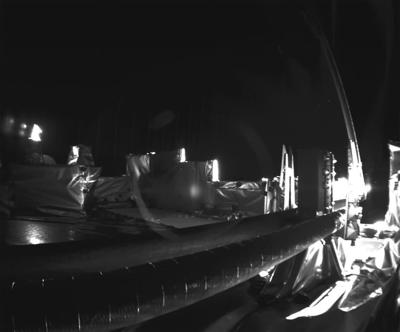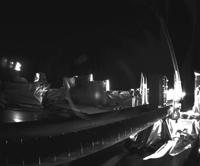CAPE CANAVERAL, Fla. (AP) — A crucial radar antenna on a European spacecraft bound for Jupiter is no longer jammed.
Flight controllers in Germany freed the 52-foot (16-meter) antenna Friday after nearly a month of effort.


In this frame grab from video provided by the European Space Agency, the second stuck part of the RIME antenna deploys, seen at right leaning vertically, on a spacecraft bound for Jupiter, Friday, May 12, 2023. Flight controllers in Germany freed the 52-foot antenna Friday, after nearly a month of effort. (European Space Agency via AP)


In this frame grab from video provided by the European Space Agency, the second stuck part of the RIME antenna deploys, seen at right leaning vertically, on a spacecraft bound for Jupiter, Friday, May 12, 2023. Flight controllers in Germany freed the 52-foot antenna Friday, after nearly a month of effort. (European Space Agency via AP)
CAPE CANAVERAL, Fla. (AP) — A crucial radar antenna on a European spacecraft bound for Jupiter is no longer jammed.
Flight controllers in Germany freed the 52-foot (16-meter) antenna Friday after nearly a month of effort.
The European Space Agency's Jupiter Icy Moons Explorer, nicknamed Juice, blasted off in April on a decade-long voyage. Soon after launch, a tiny pin refused to budge and prevented the antenna from fully opening.
Controllers tried shaking and warming the spacecraft to get the pin to move by just millimeters. Back-to-back jolts finally did the trick.
The radar antenna will peer deep beneath the icy crust of three Jupiter moons suspected of harboring underground oceans and possibly life. Those moons are Callisto, Europa and Ganymede, the largest moon in the solar system.
Juice will attempt to go into orbit around Ganymede. No spacecraft has ever orbited a moon other than our own.
The news wasn't so good for NASA's Lunar Flashlight spacecraft. After struggling unsuccessfully for months to get the Cubesat into orbit around the moon, the space agency called it quits Friday.
Launched in December, the Lunar Flashlight was supposed to hunt for ice in the shadowed craters of the lunar south pole. Now it's headed back toward Earth and then into deep space, continually orbiting the sun.
___
The Associated Press Health and Science Department receives support from the Howard Hughes Medical Institute’s Science and Educational Media Group. The AP is solely responsible for all content.
°µÍø½ûÇø. All rights reserved.
The high-profile sexual assault trial of former Canada's world junior hockey team …
This year’s Midnight Madness program at the Toronto International Film Festival wi…








Sorry, an error occurred.
Already Subscribed!
Cancel anytime
Thank you .
Your account has been registered, and you are now logged in.
Check your email for details.
Submitting this form below will send a message to your email with a link to change your password.
An email message containing instructions on how to reset your password has been sent to the email address listed on your account.
No promotional rates found.
Secure & Encrypted
Thank you.
Your gift purchase was successful! Your purchase was successful, and you are now logged in.
| Rate: | |
| Begins: | |
| Transaction ID: |
A receipt was sent to your email.